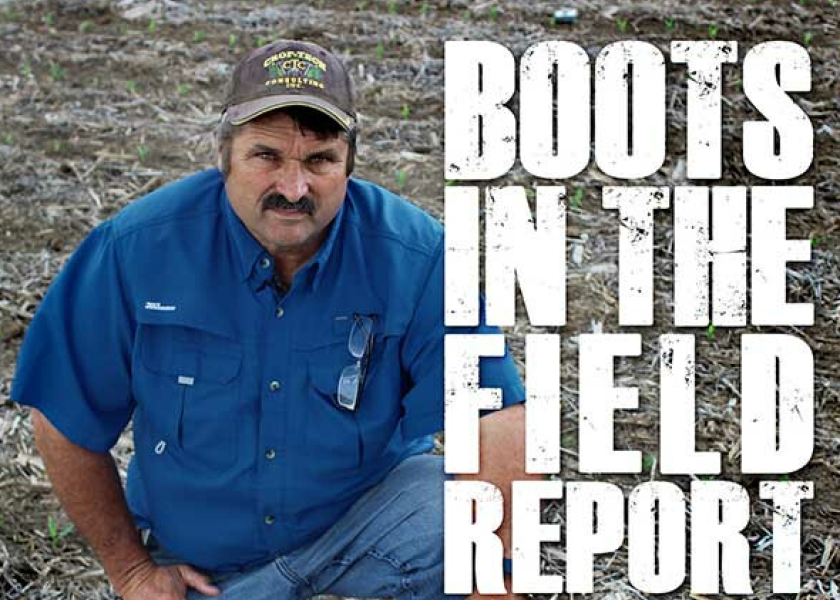Ferrie: Beware the ‘Mother’s Day Corn and Soybean Massacre’

Farmers facing cold temperatures on Thursday may want to park their planters and concentrate on celebrating the mothers in their life the next few days – instead of hurrying to get their crops in the ground.
“Our weather forecast is falling apart,” says Ken Ferrie, Farm Journal Field Agronomist and owner of Crop-Tech Consulting, near Heyworth, Ill. “We’ve had a green light for planting lately, but I’m changing it to yellow after noon today to caution farmers.
“It looks like we could be headed for the typical Mother’s Day massacre,” he adds, noting that because of cold temperatures and rain, the holiday has been associated with problematic planting and crop emergence conditions for the past four or five years.
The current weather outlook for central Illinois shows temperatures will dip into the 40s every night between Thursday and Friday, May 14.
That means farmers can anticipate few if any Growing Degree Units (GDUs) until at least late next week – a poor scenario especially for newly planted corn, which will be vulnerable to seed chilling.
“You might want to let this week pass if you can,” Ferrie says. “Anything planted after today, we’ll probably need to run a replant calculator on.”
Ferrie says having a seven to 10-day gap in planting at this stage in the season can be a positive. It can take pressure off harvesting and scouting, essentially spreading production risks.
“Plus, it doesn't get our full corn crop caught pollinating in the same week,” he adds. “It scares me when guys put their whole crop in in five days, and then we have to deal with whatever Mother Nature throws at us, because the whole crop is in the same kind of window.”
Crop-Tech Consulting Research Agronomist Matt Duesterhaus says farmers in western Illinois are having to evaluate crops that were planted in early April, to determine whether to replant.
“We got 4.5” to 5.5” of rain after Easter, then we went 14 consecutive days where we didn't get more than six GDUs on any given day,” he recalls. “So, we were planting in good conditions and avoided seed chilling coming out of the gate. But the seed sat in the ground for three weeks, and now we're struggling.”
In some cases, farmers have already ripped out crops and replanted, while others are still trying to decide what to do. It’s an unusual situation this early in the season, Duesterhaus says, noting that replant decisions are usually made in late May or early June.
“But with $6 corn and $14 beans, we want to get every bushel off of these acres,” he says.
A replant decision for corn needs to be based 100% on yield at this point in the season, Ferrie says, and not on stand counts.
“You need to be looking at ear count,” Ferrie advises. “Some of these corn crops are struggling…you may have 25,000 plants but you’re only going to get 18,000 or 19,000 ears. Here at May 6, don’t hang onto that kind of crop; it needs to come out (and be replanted).”
Crop-Tech Consulting has a calculator and worksheets posted on its website to help farmers work through replant decisions.
“You can estimate what your yield potential is right now and what your yield potential would be if you replant on a certain date, and make that decision, plugging in your costs and your price going forward. You’ll be able to use some data to make the decision, rather than letting emotion determine that,” Duesterhaus says.
The corn and soybean replant calculators are available for farmers’ use on the Crop-Tech Consulting website at https://www.croptechinc.com. Look for them at the top of the home page under the word “tools.”
For more replant considerations for corn and soybeans, as well as a discussion on early insect pressure, listen to this week’s Boots In The Field podcast here:
Ken Ferrie: Planting Recommendations Differ From A ‘Normal’ Year
Ferrie: Corn Plots Show 75-Bu. Yield Swing Based on Nitrogen Rates, Timing
Corn Planting Progress Leaps 29 Points, Beats 2020’s Historic Jump







